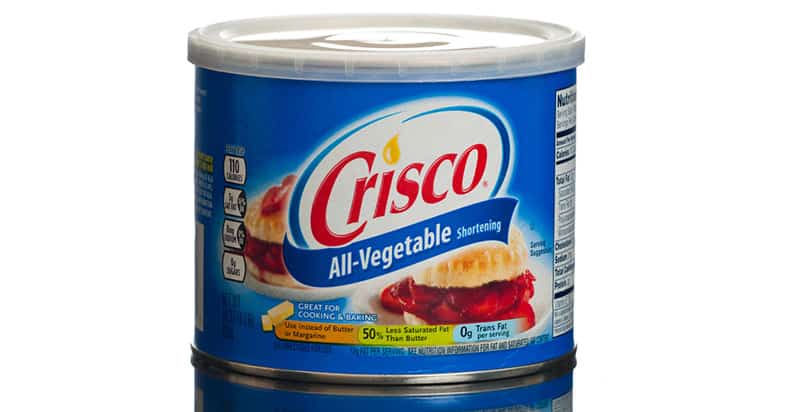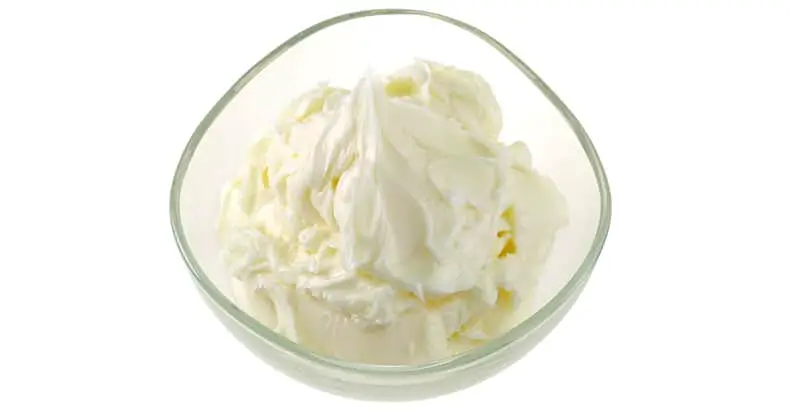Today, we’re looking at whether shortening is considered vegan-friendly. Can vegans consume it, use it to cook with, etc. Shortening is common in processed foods and baked goods like pastries, so a lot of vegans encounter it in recipes and want to know if it’s vegan.
Is it vegan? Shortening is generally considered vegan because the term is typically used synonymously with vegetable shortening. But, animal shortening does exist when the fat is sourced from animal fat (lard) or milkfat (butter). After all, any saturated or trans fat can be used to shorten dough.
This is because, in food science, the definition of shortening (the noun) is any fat that shortens, or tenderizes, the texture of baked goods by impeding the development of gluten, which makes the product softer and easier to chew.1
What we’ll do here is compare vegan and non-vegan shortenings, what fat sources they use, and along the way touch on any concerns health-conscious vegans might have.
Vegetable Shortening: The Vegan-Friendly Option

Commercial Vegetable Shortening (Crisco, Etc.)
While any fat can serve to shorten dough, here I’m referring to the stuff marketed as shortening. Vegetable shortening, often referred to as Crisco (the most widely recognized brand), is made from hydrogenating plant oils (soybean, etc.) to produce a fat that’s solid at room temperature.
When you incorporate fat into a flour mixture, it physically interferes with the gluten development, which creates a tender crumb.2
That’s why pastries have a crumbly texture.
Fat does this by literally shortening the gluten strands. The more fat you use, the shorter the strands, and the softer, more pliable, and more easily handled the dough will be. That’s where the name “shortening” comes from.3
Lubrication of the dough prevents gluten formation by creating a continuous network of protein and starch.4
This type of shortening is what most people would think of as trans fat. However, plant-based trans fat (meat also has FA’s in the trans configuration) is made by partially hydrogenating oils.
These days, vegetable shortening is produced by fully hydrogenating oils, so it’s not technically trans fat. But, it has the same effect on lipid profiles as animal-based saturated fat. So, if you’re a health-conscious vegan, you’ll definitely want to avoid vegetable shortening.
When vegetable oils are thickened past the “soft margarine stage” the result is a thick, white paste equal to margarine in its ability to improve handling (makes the dough easier to work with) and storage stability.5
If health isn’t your primary concern, vegetable shortening will give you the best outcome for your baked goods.
The useful temperature range is much wider compared to other common vegan shortenings and they come with the added benefit of having their own emulsifiers and gas for leavening.6
The emulsifiers added to shortening help distribute the fat throughout the batter, while the gas adds volume.7,8
They’re also much less expensive.
Margarine
Not all margarine is vegan, so to know for sure, make sure to check out the article on vegan butter.
Though it’s not marketed as shortening, margarine has long been used as a vegetable shortener.
Margarine used to be produced exclusively by turning vegetable oil into trans fat via partial hydrogenation.
Trans fat comes with a load of health concerns and most government food regulatory agencies have banned the use of partially hydrogenated oils.
Vegans still have an alternative to butter thanks to newer technologies that make oils solid at room temp.
Fats that are solid at room temperature provide the most shortening power. A tender crumb is the goal when making biscuits, pastries, pie crusts, and cakes.
When added to a flour mixture, saturated fat separates the starch and protein, and when heated, melts into the dough creating air pockets.
These air spaces give the baked goods the delicate texture they’re known for.9
Margarine is not as effective as commercial vegetable shortening, but it gets the job done.
Vegetable Oils
Vegetable oil isn’t really considered a shortening, but it has shortening power, and can be used as a substitute.
Veggie oils—canola, soybean, etc.—do have the ability to interfere with gluten development so they are sometimes used to replace commercial vegetable shortening. Especially in instances when the shortening needed for a recipe isn’t on hand or when a super tender product is desired.
Oil kinda goes overboard with the shortening by coating flour too thoroughly which prevents adequate gluten development (i.e. some gluten is needed). It’s similar to the problem you run into when too much fat is used overall.
Liquid and fat have to be added in the right ratio (liquid at 1/5 the amount of fat) to maintain the right consistency.
While fat makes the dough softer and allows it to rise more, adding too much (> 20% of the flour’s weight) makes the end product too “short” lowering the volume, weakening the gluten structure and tearing of the crumb.10
For this reason, liquid fat isn’t used very often in baked goods.
Having said that, sometimes oil is preferred when tenderness is the main goal—as with brownies and some cakes. And oil is always vegan.
Non-Vegan Shortening
Lard Isn’t Vegan
As mentioned in the article on whether croissants are vegan, lard is a fairly common non-vegan shortening. Crescent rolls have a crumbly texture, and some manufacturers and bakers opt for lard for some reason.
I’ve been asked before if lard can be vegan and the answer is no. Lard is just another word for pure hog fat.11
It’s one of the more common animal shortenings, but it’s still much less common than vegetable shortenings like Crisco.
Lard is animal fat in its “rendered” form—rendering is the process by which animal tissue is converted into a usable form.
The crude animal fat is first deodorized at which point antioxidants are often added to lengthen shelf life by preventing rancidity.11
So, like butter, lard is prone to becoming rancid.
This is good news for vegans because a lot more food products are made “accidentally” vegan that would otherwise contain animal shortening.
Contrast that with the early 1900s when lard was the primary shortening used.
Tallow Is Not Vegan
Tallow is like lard, but it’s sourced from beef cattle, not pigs.
It’s synonymous with beef or mutton fat, and it’s made up largely of saturated fat so it’s solid at room temperature.
It has a longer shelf life compared to other animal shortenings as it’s not as prone to oxidation. But, thankfully for vegans, it’s not commonly used in processed food products.
Keep in mind that the technical definition of tallow is not strictly limited to beef or mutton fat—instead, it has to do with criteria like melting point.
But when most use the term tallow, they’re usually referring to beef fat.
Fortunately for vegans, tallow is not nearly as common vegetable shortenings in processed foods and pastries. In fact, it’s mostly used in animal food, like dog food, and non-food products like soap.12-14
What soaps are suitable for vegans is a topic for another article, just know tallow is a common ingredient in both commercial and homemade soaps.
The bottom line is that tallow does have shortening power, but it’s not commonly used for this application.
Suet (Beef and Sheep Fat)
Suet is the solid fat located around the kidneys and loin of beef and sheep. I highly doubt you’ll ever see “suet” listed on any ingredients panel, but it can be used as an animal shortening once rendered so I’m listing it here.
According to the Spruce Eats, suet is still used in home cooking.15
But, to the extent that it’s used in recipes, it seems to be in preparations that are obviously non-vegan, like meat pie. So, it shouldn’t be an issue trying to avoid it.
Butter Isn’t Cruelty Free
According to Wikipedia, butter is seldom referred to as a shortening.16
But, like lard, butter can be used as a shortener. It’s less desirable for functional reasons because vegetable shortening and margarine have a long shelf life, while butter goes rancid pretty quickly.
Also, cakes made with vegetable shortenings have a higher volume and better texture.
However, butter is saturated fat and it has a taste that can’t be duplicated, so it’s sometimes used.
Ghee
Ghee is a type of clarified butter that some use for shortening. Like regular butter, it’s not marketed as a shortening, but it does fit the broader definition of a shortener.
You’re more likely to encounter ghee in Indian and Middle Eastern cuisine, so you probably won’t have to contend with it in baked goods—though, using it as a shortening substitute is not unheard of.17
Is Vegetable Shortening Vegan? Conclusion
So, shortenings are types fat that are solid at room temp and used in baked goods to interfere with gluten development. Because most solid fats are of animal origin, it’s understandable why the ingredient might trigger an alarm.
The most common shortening is the stuff marketed as vegetable shortening and often referred to as Crisco (even if it’s off-brand).
Commercial vegetable shortening is made by taking oil, the plant-based form of fat that’s liquid at room temp, and hydrogenating it, making a pasty white substance that’s solid and pliable at room temperature. So, this stuff is vegan.
Margarine is the second most common shortening in processed foods and baked goods.
These days, margarine is made using methods other than partial hydrogenation—it’s an emulsification of a blend of vegetable oils that are modified via “interesterification”.18-20
I’ll spare you the details just know that it’s usually vegan, but watch out for dairy derivatives.
For ethical purposes, most vegans will be pleased to know that shortening is cruelty-free, but those who are particularly concerned with health will want to limit their consumption as much as possible.
Animal shortenings do exist, but they’re used much less regularly. When you encounter them, it’s usually in the form of butter or lard.
Lard, or rendered hog fat, is most frequently found in commercial crescent rolls and tortillas. It’s also in non-vegetarian refried beans but not as a shortener.
That should do it for now. Thanks for reading.
References
- Understanding Food: Principles and Preparation (Page 454). Amy Brown – Wadsworth Cengage Learning – 2011. ISBN-10: 0-538-73498-1
- Stauffer CE. Fats and Oils: Practical Guides for the Food Industry. Eagen Press, 1996. https://onlinelibrary.wiley.com/doi/abs/10.1002/food.19960400514
- Stauffer CE, et al. Fats and oils in bakery products. Edible Oil and Fat Products: Products and Applications. Feb 2020. https://onlinelibrary.wiley.com/doi/10.1002/047167849X.bio075.pub2
- Gallagher E. Formulation and nutritional aspects of gluten-free cereal products and infant foods. In EK Arendt and F Dal Bello. Gluten-free Cereal Products and Beverages, 2008. https://www.sciencedirect.com/science/article/pii/B9780123737397500162
- Best D. The challenges of fat substitution. Prepared Foods 160(6):72–76, 1992.
- Thompson SW, and JE Gannon. Observations on the influence of texturation, occluded gas content, and emulsifier content on shortening performance in cake making. Cereal Chemistry Vol 33:181–189, May 1956.
- Mettler E, and W Seibel. Effects of emulsifiers and hydrocolloids on whole wheat bread quality: A response surface methodology study. Cereal Chemistry 70(4):373– 377, 1993. https://agris.fao.org/agris-search/search.do?recordID=US9434138
- Understanding Food: Principles and Preparation (Page 381). Amy Brown – Wadsworth Cengage Learning – 2011. ISBN-10: 0-538-73498-1
- Understanding Food: Principles and Preparation (Page 455). Amy Brown – Wadsworth Cengage Learning – 2011. ISBN-10: 0-538-73498-1
- Schunemann C, and G Treu. Baking: The Art and Science. A Practical Handbook for the Baking Industry. Baker Tech, 1988.
- Understanding Food: Principles and Preparation (Page 464). Amy Brown – Wadsworth Cengage Learning – 2011
- Pentobarbital Continues To ‘Dog’ Pet Food Industry; Beef Tallow Blamed. https://thebark.com/content/pentobarbital-continues-dog-pet-food-industry-beef-tallow-blamed
- Tallow feed for pets: 7 reasons to use beef tallow in pet food. http://beeftallow.com/uses-of-beef-tallow_tallow-feed-for-pets-7-reasons-to-use-beef-tallow-in-pet-food_45.html
- Soap industries prefer animal tallow to vegetable fat torturing many creatures in the process. https://www.firstpost.com/india/soap-industries-prefer-animal-tallow-to-vegetable-fat-torturing-many-creatures-in-the-process-3474210.html
- What Is Suet? The Spruce Eats. https://www.thespruceeats.com/what-is-suet-and-alternatives-to-suet-in-british-food-435414
- Shortening – https://en.wikipedia.org/wiki/Shortening
- Clarified Butter: A Substitute for Shortening? https://www.cooksillustrated.com/how_tos/9390-clarified-butter-a-substitute-for-shortening
- Making Trans-Fat Free Margarine. https://www.mcgill.ca/oss/article/science-science-everywhere/making-trans-fat-free-margarine
- Margarine. https://en.wikipedia.org/wiki/Margarine
- Baker Christopher G.J; Ranken H.D; Kill R.C., eds. (1997). Food industries manual. 24th Edition. Springer. pp. 285–289. ISBN 978-0-7514-0404-3.

